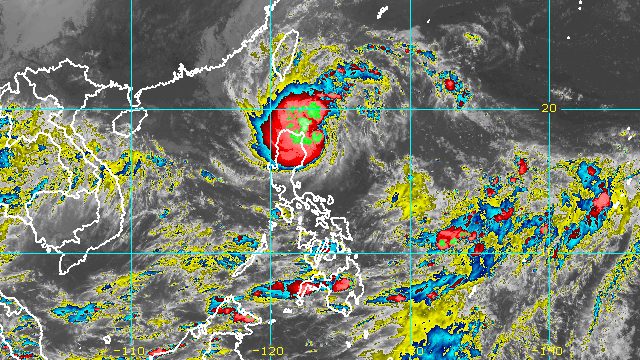SUMMARY
This is AI generated summarization, which may have errors. For context, always refer to the full article.

MANILA, Philippines – Neneng strengthened from a tropical depression into a tropical storm at 2 pm on Saturday, October 15, as it accelerated over the Philippine Sea.
Neneng’s maximum sustained winds increased from 55 kilometers per hour to 65 km/h, the Philippine Atmospheric, Geophysical, and Astronomical Services Administration (PAGASA) said in a bulletin released past 5 pm on Saturday. Its gustiness is now up to 80 km/h from the previous 70 km/h.
As Neneng intensified into a tropical storm, it was given the international name Nesat.
PAGASA also said Neneng may strengthen further into a severe tropical storm while in the Babuyan Islands-Batanes area on Sunday morning, October 16, and into a typhoon on Tuesday, October 18, when it would already be outside the Philippine Area of Responsibility (PAR).
PAGASA expects Neneng to pass very close to or make landfall in Babuyan Islands or Batanes on Sunday morning.
As of Saturday afternoon, the tropical storm was already 255 kilometers east southeast of Calayan, Cagayan, or 230 kilometers east of Aparri, Cagayan, moving west at 30 km/h from the previous 15 km/h.
Signal No. 2 has been raised for the first time due to Neneng. Below are the areas under tropical cyclone wind signals as of 5 pm on Saturday.
Signal No. 2
Gale-force winds (62 to 88 km/h), minor to moderate threat to life and property
- Batanes
- Cagayan including Babuyan Islands
- Apayao
- northern part of Abra (Tineg, Lacub, Lagayan)
- Ilocos Norte
Signal No. 1
Strong winds (39 to 61 km/h), minimal to minor threat to life and property
- northern part of Isabela (Santa Maria, San Pablo, Maconacon, Divilacan, Palanan, Ilagan City, Tumauini, Cabagan, Santo Tomas, Quezon, Delfin Albano, Mallig, Quirino, Gamu, Roxas)
- Kalinga
- rest of Abra
- northern part of Mountain Province (Paracelis, Natonin, Barlig, Sadanga, Bontoc, Sagada, Besao)
- northern part of Ilocos Sur (Sinait, Cabugao, San Juan, Magsingal, Santo Domingo, San Ildefonso, San Vicente, Santa Catalina, Bantay, Vigan City, Santa, Caoayan, Narvacan, Nagbukel, Santa Maria, San Esteban, Santiago, Burgos, Banayoyo, Lidlidda, San Emilio, Quirino, Gregorio del Pilar, Galimuyod, Candon City, Santa Lucia, Salcedo)
At the moment, the highest possible wind signal is Signal No. 3 since Neneng is likely to intensify into a severe tropical storm.
But PAGASA is now saying that the possibility of Signal No. 4 being raised is not ruled out, in case Neneng becomes a typhoon earlier than currently projected.
The weather bureau added that there may be occasional gusts in Southern Luzon and the Visayas due to the convergence between Neneng’s circulation and the southwesterly winds.
Neneng may also trigger floods and landslides as it dumps rain in Northern Luzon this weekend. PAGASA maintained the following rainfall forecast for the tropical storm:
Until Saturday evening, October 15
Heavy to intense rain, with at times torrential rain
- Batanes
- Cagayan including Babuyan Islands
Moderate to heavy rain, with at times intense rain
- Apayao
- Kalinga
- Abra
- Ilocos Norte
Light to moderate rain, with at times heavy rain
- northern part of Isabela
- rest of Cordillera Administrative Region
- rest of Ilocos Region
Sunday, October 16
Heavy to intense rain, with at times torrential rain
- Batanes
- northern part of mainland Cagayan
- Babuyan Islands
- Ilocos Norte
Moderate to heavy rain, with at times intense rain
- Apayao
- Kalinga
- Abra
- Ilocos Sur
- rest of mainland Cagayan
Light to moderate rain, with at times heavy rain
- northern part of Isabela
- rest of Cordillera Administrative Region
- rest of Ilocos Region
The weather bureau also said the trough or extension of the tropical storm “and the convergence of its circulation with the southwesterly winds” could bring occasional rain to the western parts of Mimaropa and Western Visayas. A separate weather advisory may be issued.
Meanwhile, PAGASA released a new gale warning at 5 pm on Saturday due to both Neneng and the northeasterly surface windflow. Seas are rough to very rough in these seaboards:
- seaboards of Northern Luzon (Batanes, Cagayan, Ilocos Norte) – waves 3.4 to 5 meters high
- eastern seaboard of Northern Luzon (Isabela) – waves 3.1 to 4.5 meters high
- western seaboard of Northern Luzon (Ilocos Sur, La Union) – waves 2.8 to 4.5 meters high
PAGASA advised fishing boats and other small vessels not to sail, and larger vessels to watch out for big waves.
The weather bureau added that the surge of the northeasterly surface windflow and Neneng may cause moderate to rough seas in the eastern seaboards of Central Luzon and Southern Luzon. Waves could be 2 to 3.5 meters high, making conditions risky for small vessels.
Neneng could leave PAR on Monday, October 17, as it shifts southwest “in response to an arriving northeasterly surge,” PAGASA said.

Neneng is the Philippines’ 14th tropical cyclone for 2022 and the second for October.
PAGASA expects 5 to 9 tropical cyclones to enter or develop inside PAR from October 2022 to March 2023. Per month, these are the weather bureau’s estimates:
- October 2022 – 2 to 4
- November 2022 – 2 or 3
- December 2022 – 1 or 2
- January 2023 – 0 or 1
- February 2023 – 0 or 1
- March 2023 – 0 or 1
– Rappler.com
Add a comment
How does this make you feel?




There are no comments yet. Add your comment to start the conversation.